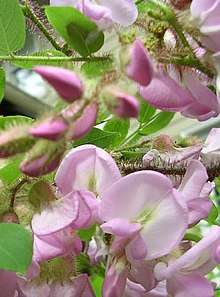Robinia hispida
Robinia hispida, known as the bristly locust,[1] rose-acacia, or moss locust, is a shrub in the subfamily Faboideae of the pea family Fabaceae. It is native to the southeastern United States,[2] and it is present in other areas, including other regions of North America, as an introduced species. It is grown as an ornamental and can escape cultivation and grow in the wild.[3]
| Robinia hispida | |
|---|---|
 | |
| Scientific classification | |
| Kingdom: | |
| (unranked): | |
| (unranked): | |
| (unranked): | |
| Order: | |
| Family: | |
| Genus: | |
| Species: | R. hispida |
| Binomial name | |
| Robinia hispida | |
Description
This deciduous shrub grows to 3 meters tall, often with glandular, bristly (hispid) stems. The leaves are pinnate with up to 13 leaflets. The pink or purplish pealike flowers are borne in hanging racemes of up to 5. The fruit is a flat pod.[3]
Ethnobotany
The Cherokee had several uses for the plant. They used the root medicinally for toothache. They fed an infusion of the plant to cows as a tonic. The wood was useful for making fences, bows, and blowgun darts, and for building houses.[4]
Subtaxa
There are at least 5 varieties:[2][5][6]
- R. hispida var. fertilis - Arnot bristly locust (North Carolina, Tennessee)
- R. hispida var. hispida - Common bristly locust (Originally endemic to the Southern Appalachian Mountains but now escaped from cultivation throughout much of eastern North America)
- R. hispida var. kelseyi - Kelsey's locust (North Carolina, sometimes considered to have arisen as a horticultural variety, sometimes considered a distinct species)
- R. hispida var. nana - Dwarf bristly locust (Found in the Piedmont and Coastal Plain from North Carolina south to Alabama, typically in dry, sandy soils such as those in the Sandhills region; sometimes considered a distinct species as R. nana)
- R. hispida var. rosea - Boynton's locust (North Carolina, Tennessee, South Carolina, Georgia, Alabama)
References
- "Robinia hispida". Natural Resources Conservation Service PLANTS Database. USDA. Retrieved 22 October 2015.
- "Robinia hispida". Germplasm Resources Information Network (GRIN). Agricultural Research Service (ARS), United States Department of Agriculture (USDA). Retrieved 12 January 2018.
- Robinia hispida. Burke Museum of Natural History and Culture. University of Washington. 2013.
- Robinia hispida. Native American Ethnobotany. University of Michigan, Dearborn.
- Weakley, Alan (November 2012 Working Draft). Flora of the Southern and Mid-Atlantic States. University of North Carolina Herbarium. pp. 516–517. Check date values in:
|date=(help) - Lance, Ron (2004). Woody Plants of the Southeastern United States: A Winter Guide. University of Georgia Press. ISBN 9780820325248.
